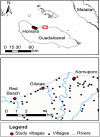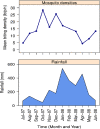The bionomics of the malaria vector Anopheles farauti in Northern Guadalcanal, Solomon Islands: issues for successful vector control
- PMID: 24528850
- PMCID: PMC3929755
- DOI: 10.1186/1475-2875-13-56
The bionomics of the malaria vector Anopheles farauti in Northern Guadalcanal, Solomon Islands: issues for successful vector control
Abstract
Background: The north coast of Guadalcanal has some of the most intense malaria transmission in the Solomon Islands. And, there is a push for intensified vector control in Guadalcanal, to improve the livelihood of residents and to minimize the number of cases, which are regularly exported to the rest of the country. Therefore, the bionomics of the target vector, Anopheles farauti, was profiled in 2007-08; which was after 20 years of limited surveillance during which time treated bed nets (ITNs) were distributed in the area.
Methods: In three villages on northern Guadalcanal, blood-seeking female mosquitoes were caught using hourly human landing catches by four collectors, two working indoors and two outdoors, from 18.00-06.00 for at least two nights per month from July 2007 to June 2008. The mosquitoes were counted, identified using morphological and molecular markers and dissected to determine parity.
Results: Seasonality in vector densities was similar in the three villages, with a peak at the end of the drier months (October to December) and a trough at the end of the wetter months (March to May). There was some variability in endophagy (indoor biting) and nocturnal biting (activity during sleeping hours) both spatially and temporally across the longitudinal dataset. The general biting pattern was consistent throughout all sample collections, with the majority of biting occurring outdoors (64%) and outside of sleeping hours (65%). Peak biting was 19.00-20.00. The proportion parous across each village ranged between 0.54-0.58. Parity showed little seasonal trend despite fluctuations in vector densities over the year.
Conclusion: The early, outdoor biting behaviour of An. farauti documented 20 years previously on north Guadalcanal was still exhibited. It is possible that bed net use may have maintained this biting profile though this could not be determined unequivocally. The longevity of these populations has not changed despite long-term ITN use. This early, outdoor biting behaviour led to the failure of the eradication programme and is likely responsible for the continued transmission in Guadalcanal following the introduction of ITNs. Other vector control strategies which do not rely on the vector entering houses are needed if elimination or intensified control is to be achieved.
Figures



References
-
- World Health Organization. World malaria report 2012. Geneva: World Health Organization; 2012.
-
- Avery J. A review of the malaria eradication programme in the British Solomon Islands 1970–1972. P N G Med J. 1974;17:50–60. - PubMed
Publication types
MeSH terms
Grants and funding
LinkOut - more resources
Full Text Sources
Other Literature Sources
Molecular Biology Databases

